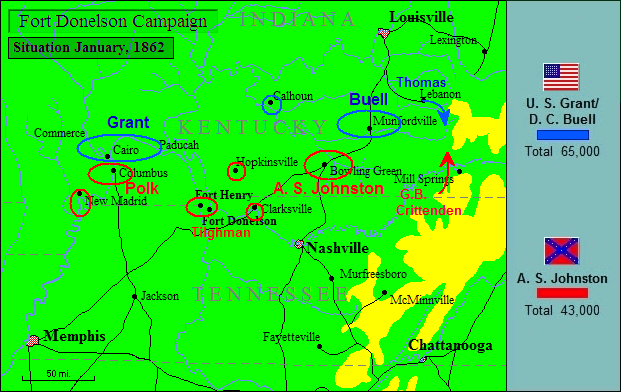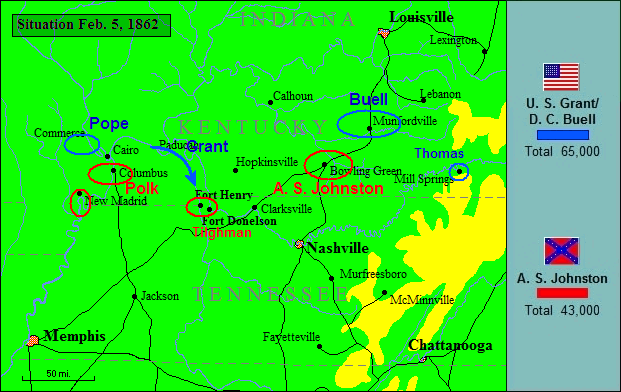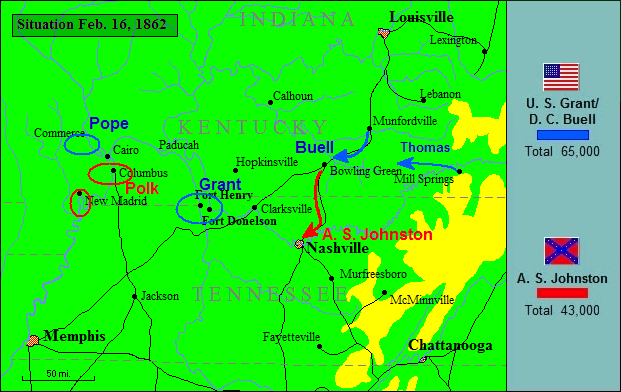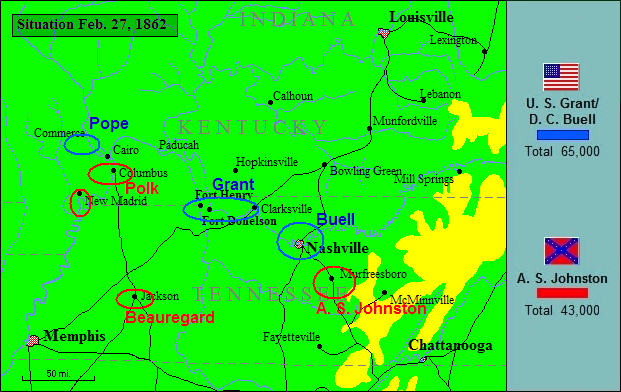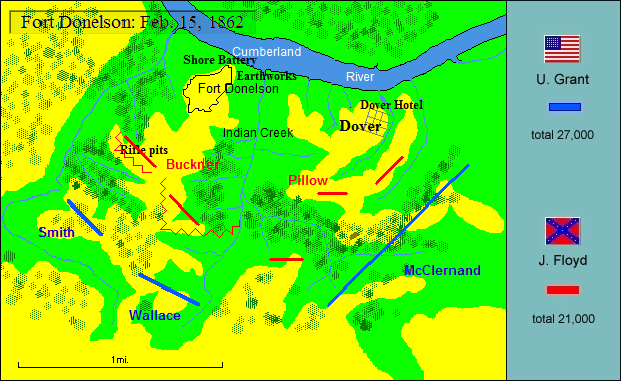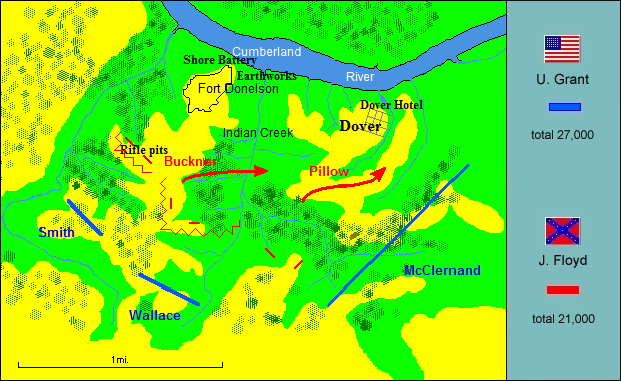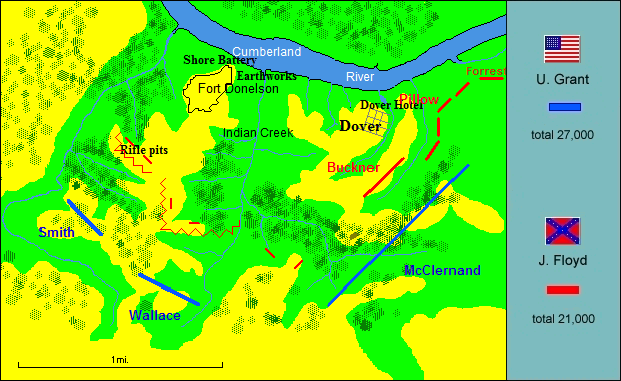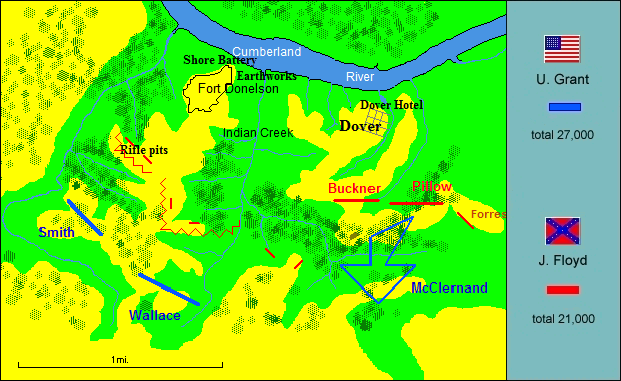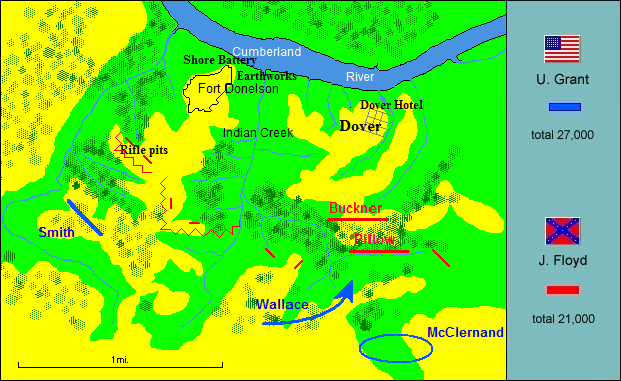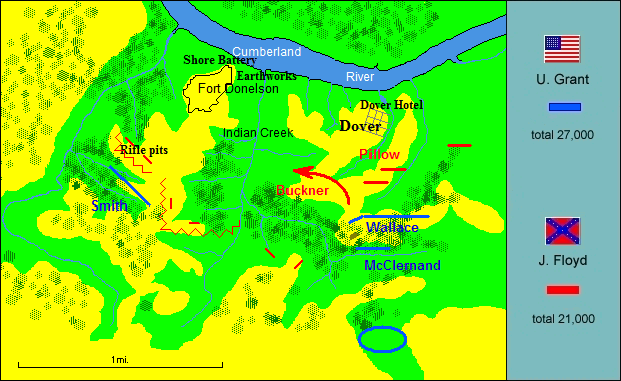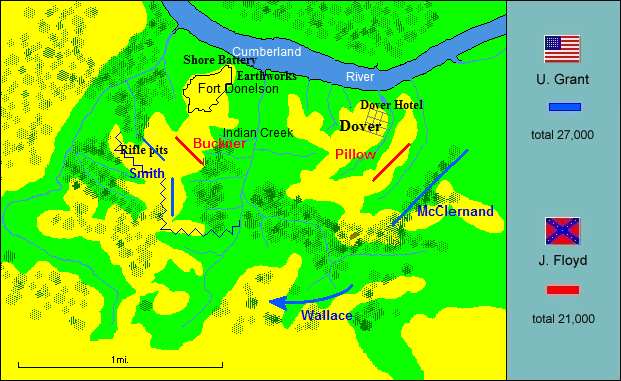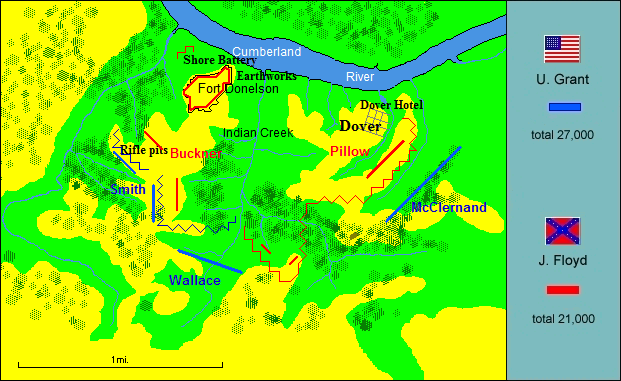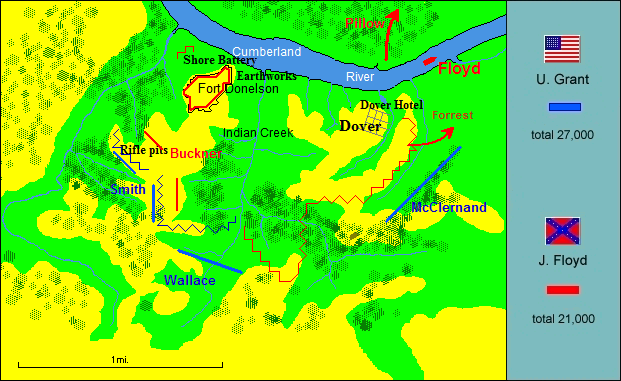No terms except an immediate and unconditional surrender can be accepted. I propose to move immediately upon your works.
–Ulysses S. Grant to Simon Buckner
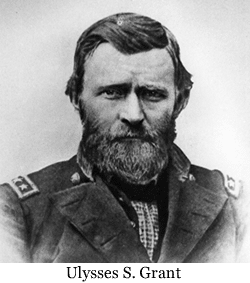
The task of defending the West fell to one of Jefferson Davis’s favorites, Major General Albert Sidney Johnston, handsome and personable and thought by many to be the South’s ablest soldier. His Department of Missouri covered a 500-mile front reaching from the eastern border of Kentucky to Missouri’s southwest corner. His 70,000 troops, poorly armed and equipped, confronted 150,000 Federals. Against these long odds he had, however, one advantage: a divided Federal command structure. West of the Cumberland River, Henry Halleck commanded the Department of the Missouri; east of it Don Carlos Buell commanded the Department of the Ohio. Halleck had a reputation as the old army’s intellectual, but “Old Brains,” as he was sometimes called, was an administrator, not a fighting field commander. Buell likewise was an able administrator but slow, cautious, and tentative in the field. Neither was eager to act decisively nor to cooperate with one another effectively. Yet once the Federal campaign for the control of the Tennessee and Cumberland Rivers actually got underway, active leadership would fall on two aggressive commanders: one a Connecticut-born, fresh-water sailor, Flag Officer Andrew H. Foote; the other that determined little brigadier from Illinois, Ulysses S. Grant.
At the beginning of 1862, the line of the Mississippi was effectively closed to Federal operations chiefly due to the engineering of Confederate general Leonidas Polk. Upon seizing Columbus, Kentucky, back in September of ’61, Polk had set to work fortifying that place, and by February of ’62 the presence of 140 heavy guns on high bluffs commanding the river went a long way to make it, as Southerners proudly put it, the “Gibraltar of the West.” Confederate defenses on the Tennessee and Cumberland, however, were much less formidable. If the Federals could gain control of Fort Henry on the Tennessee, northern Mississippi and Alabama were open to invasion. If they could clear Fort Donelson on the Cumberland, the river road to Nashville, Tennessee, would be open. With 15,000 men at Cairo, Illinois, which controlled the mouths of both rivers, Ulysses Grant was in the right place at the right time to make such an effort. Events would prove that he was also the right man in the right place.
The first blow of the campaign for control of the Western rivers came at the eastern extremity of Johnston’s line, where a small Confederate force under Major General George Crittenden crossed the Cumberland and headed north to threaten central Kentucky. Marching to confront this threat was Brigadier General George Thomas, a Virginia-born Union man who would earn a lasting name as a redoubtable fighter. The collision occurred near the village of Mill Springs, where Crittenden’s force was soundly beaten. In one blow the right of Johnston’s long line was gone.
The effort on Johnston’s left began when Halleck, after months of indecision, ordered Grant to seize Fort Henry on the Tennessee. Grant’s plan was simple: he would move his 15,000 men by transport and invest Fort Henry by land. At the same time Flag-Officer Foote would steam upriver with his flotilla of gunboats and attack the fort from the river. These gunboats were shallow-draft paddle-wheelers, protected by a sharply-angled iron casemate. They looked to some like turtles and were thus known as “Pook’s turtles,” after Samuel Pook, the designer of the casemate. As playful as the name sounded, however, there was nothing playful about their purpose, for each carried thirteen heavy guns.
Indeed, the capture of Fort Henry would be one of the easiest victories of the war. Although commanded by a tough-minded Kentucky brigadier, Lloyd Tilghman, Fort Henry was a difficult place to defend under the best of circumstances. Built on a low bank of the Tennessee River surrounded by high hills, it was subject to flooding whenever the river rose, and as it happened, six of its guns were underwater at the time of the attack. Those that remained high and dry were ancient and inadequate, and to make matters worse the garrison itself was small and poorly armed. In any case, on February 5, 1862, Grant got his men in transports and, under the protection of four of Foote’s “turtles,” landed them a few miles below the fort. While Grant attacked from the rear, Foote was to attack from the river. Before the infantry could reach the fort along rain-soaked roads, however, the navy opened the fight. Tilghman saw immediately the hopelessness of his position: Foote could bring 54 guns to bear on the fort, while he, Tilghman, could answer with only nine. He therefore sent his garrison on a twelve mile trek cross-country to Fort Donelson, and with a rear-guard artillery company put up a gallant little fight. Two hours later, well before the first of Grant’s infantry could reach the place, Tilghman surrendered. At this point, Foote sent three gunboats steaming up the Tennessee as far as Muscle Shoals, Alabama, wrecking Confederate ships and sowing panic in the heartland as he went. Grant, meanwhile, telegraphed Halleck news of the victory: “Fort Henry is ours,” he wrote. “I shall take and destroy Fort Donelson on the 8th.”
Johnston–and indeed the whole Confederate high command–was beginning to see with terrible clarity the unsettling dimensions of their predicament. George Thomas had knocked Johnston’s right loose at Mill Springs; now Grant had punched a hole in his center. Buell’s army was still in middle Kentucky, square across the Louisville and Nashville railroad and threatening the latter place. In response, Jefferson Davis sent Beauregard to confer with Johnston about a strategic plan to shore up the collapsing Confederate line. Beauregard, whose aggressive action at First Bull Run had won him a “handsome victory,” urged swift and decisive blows: hit Grant hard, then turn on Buell. To Johnston, the plan seemed long odds. Rather than striking each Federal army separately, Johnston might–if the Yankees concentrated fast enough–be struck himself on both flanks simultaneously. Johnston first argued for a withdrawal to the southwest, saving his army and looking for an opportunity to fight on more favorable terms. The rub here was that retreat meant abandoning Nashville, whose vital industry and railroads the South could not afford to lose. Stuck between two perilous alternatives, Johnston settled on a curious and controversial half-measure. He decided to reinforce Donelson with 12,000 men in hopes that they could hold off Grant. But Johnston’s choice for the command of Donelson did not bode well. It was John Floyd, infamous with Northerners who believed that he had shipped arms South as President Buchanan’s Secretary of War. With Southerners, he was hardly more popular for his inept performance in the mountains of western Virginia. Nevertheless, having made his choice, Johnston withdrew to Nashville with the rest of his army.
As the roads dried and the weather warmed, Grant moved his men eastward cross-country following the route of Fort Henry’s luckless garrison. Their easy victory and the pleasure of marching roads that had a bottom to them put them in a buoyant mood. Many tossed greatcoats and blankets aside–acts they would have full cause to regret on miserable nights soon to come. Grant had wired Halleck of his intent to take and destroy Donelson on February 8, but between the rain and the delays in getting his column organized, he was not in front of Donelson until the twelfth. Fort Donelson itself was no Gibraltar, but neither was it Henry. On the Cumberland River side a dozen guns stood ready to contest Foote’s gunboats. On the land side ran three semi-circular lines of trench. Manning them was a garrison that had swelled to 16,000 with the recent arrival of Johnston’s reinforcements–a force slightly larger than Grant’s own at this point. Still, it was the Confederate garrison and not Grant’s army that was in mortal danger.
Grant, reiterating his Fort Henry plan, determined to invest Donelson on the land side with infantry and pound it from the river with Foote’s ironclads. After receiving 10,000 reinforcements, Grant on the 14th ordered Foote to steam upriver and commence firing while his infantry and artillery pressed the Confederate trenches. Foote was himself something of an anomaly: a sailor who abhorred both rum and profanity. But as a highly capable seaman, he had some doubts that his ironclads were entirely the invincible technological terrors the Rebels feared they were. Closing to within a mile of the fort on the afternoon of the 14th, his four ironclad and two wooden gunboats opened up from a point out of range of the lighter Rebel guns. He might have wisely remained at that range too, but, reiterating his own tactics at Henry, he pressed his attack to within 400 yards of Donelson’s water batteries. At this distance his guns were overshooting their mark, but the Confederates were driving their shots home with a will. In the end, Foote’s flotilla was driven back downstream badly hurt. Foote’s own flagship, the Saint Louis, was struck 59 times and went rudderless downstream, Foote himself slightly wounded. Although he had more than fifty seamen dead, he had not silenced a single gun nor killed a single gunner. The water-borne Achilles, had, at least momentarily, discovered his vulnerable heel.
This respite from destruction, however, did not mean that the Confederate situation was anything less than critical: sooner or later, remaining in Donelson would mean destruction or surrender. Inside the fort, Floyd convened a council of war with Brigadier General Gideon Pillow, his second-in-command, and Brigadier General Simon Bolivar Buckner. Although Pillow had fought in Mexico, neither officers nor men had much confidence in him. In fact, when all was said and done, the one distinction in Pillow’s war record was that he was the only officer on either side whom Grant spoke contemptuously of in his memoirs. Buckner had led Home Guards back in the days of Kentucky’s tenuous neutrality. Of the three defending commanders, he was the ablest soldier, but he was third in command. In any case, the council agreed that the garrison would try to break its way out in the morning. Massing their forces on the left (Pillow’s front), they would punch a hole in the Union right at break of day, open a corridor of escape, and double-quick down the Nashville road.
If things looked desperate in the Rebel camps on the night of February 14th, there was a good measure of misery in the Yankee camps too. The weather took a nasty turn, and scouring sleet and snow made many a shivering trooper regret a coat or a blanket left on the road from Fort Henry. The Union right was held by a division commanded by John McClernand. On the bright winter dawn of the 15th, Pillow’s infantry with Nathan Bedford Forrest’s cavalry on his flank drove into McClernand’s division. The fighting was sharp all along a front five-brigades wide, but after three hours the Rebels had made the full weight of their attack felt. McClernand’s men, now exhausted and out of ammunition, had been driven more than a mile. Further, their withdrawal had exposed the flank of a division in the center belonging to Lew Wallace. By noon the corridor that Pillow had planned was achieved: the road to Nashville was open and Buckner’s troops were on hand to hold it open while the column marched through and away. Pillow wired to Johnston a curious telegram: “On the honor of a soldier, the day is ours!” If the expression “the day is ours” means “we have won a decisive victory,” then nothing of the kind had taken place. But what Pillow had achieved was no mean feat: the opportunity was at hand to save his army from destruction.
What Pillow did next was even more curious: he chose not to seize the opportunity his men had fought so fiercely to gain, ordering his divisions back into their trenches. From this distance, it is hard to imagine what Pillow was thinking. Perhaps he thought he could hold the place after all; perhaps he thought his troops were too fought-out to make a hard march and would be caught in flank by a Yankee counterattack. In any event, Floyd arrived on the scene and–over Buckner’s vehement protests–confirmed Pillow’s order. Fort Donelson was finished. Grant, a quiet man with a combative nature, arrived on the Union right and quickly appraised the situation. As Lew Wallace remembered it, Grant said: “Some of our men are pretty badly demoralized, but the enemy must be more so, for he has attempted to break out, but has fallen back: the one who attacks first now will be victorious.” Grant ordered a counterattack, regained what the morning’s fighting had lost, and with Foote shelling the fort from the river and Smith’s men pressing hard in front, the Federals once more closed the ring.
What happened next was not the Confederacy’s finest hour. Floyd, seeing the inevitability of Donelson’s surrender, wanted no part of it. First there was that little matter of looting Federal arsenals in Buchanan’s administration. Graver yet, what Southerners were calling “the Revolution of 1860,” many hard-shell Unionists were calling treason–a hanging offense. Floyd handed the command over to Pillow, boarded a steamer, and fled upstream. Pillow in turn handed the command to Buckner and soon after followed Floyd to safety. There was in this shabby proceeding one bright moment for the Rebels that many Yankees would have cause to regret. The cavalryman Bedford Forrest, a self-made man and self-taught military genius, was absolutely outraged. He hadn’t brought his command to Donelson to surrender it, he told Buckner; he would take his people out or “bust hell wide open.” In the icy darkness, he took his troopers through Grant’s lines. Later William Tecumseh Sherman would pay him a high compliment, calling him simply “that devil Forrest.” All this of course left Buckner holding the bag. He wrote to Grant asking for surrender terms and hoping for the best. He and Grant had after all been friendly, if not friends, in the old army, and once, when Grant was down on his luck, Buckner had reached into his pocket to hand him a small loan. Reading Grant’s reply, Buckner understandably found it “ungenerous and unchivalrous,” and in truth it was. To Buckner, Grant wrote: “No terms except an immediate and unconditional surrender can be accepted. I propose to move immediately on your works.” Perhaps chivalry too was becoming a casualty of war. In any case, by February 16, 1862, Grant’s army had hammered a crack in the Confederacy’s western wall. As for U. S. Grant, Northern papers would begin to write that U. S. stood for “Unconditional Surrender.

